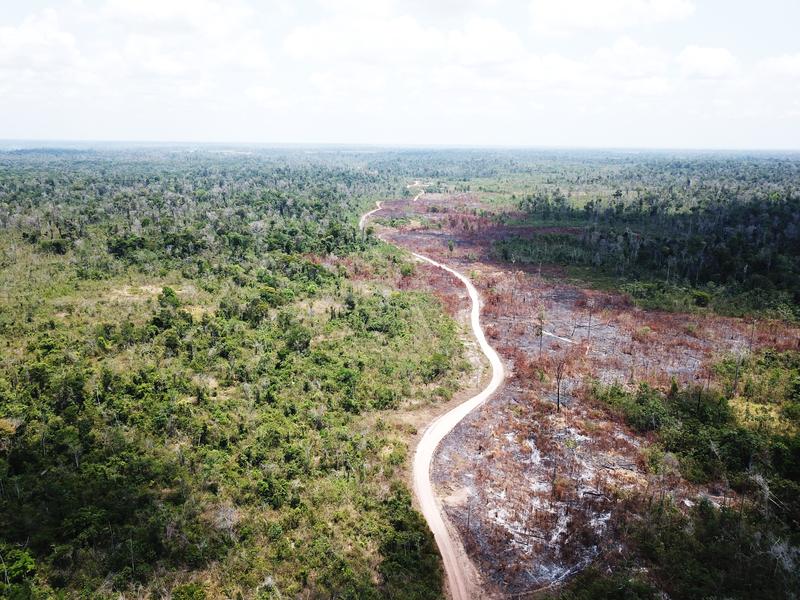Human degradation of tropical forests is greater than previously estimated
Tropical forests are essential to sustain high biodiversity and mitigate climate change. They suffer from deforestation, the cutting and converting of forests for agriculture, mining, or infrastructure purposes. However, significant human impacts on the remaining forests that lead to their degradation are often overlooked. By using multiple remote sensing data streams and cutting-edge data analysis, researchers now acquired an unprecedented view of the extent and long-lasting effects of such degradation in tropical moist forests. Their study, published in Nature, reveals that the effects of human-driven degradation and fragmentation are greater than previously estimated.
In order to protect biodiversity and enhance forests' critical role in mitigating climate change, world-wide forest loss needs to be halted urgently, as recently highlighted by the United Nations Climate Change and Biodiversity Conferences. Reducing forest loss in the moist tropical domain is particularly essential to achieving these goals. But when talking about forest loss, the focus is mostly on deforestation, i.e. the cutting of larger forest areas and its conversions to agriculture, mining, or infrastructure functions. Yet, a whole gradient of forest states exists, spanning from intact forests to remaining but degraded forests, which are usually located at the edges and within fragmented landscapes.
Remaining forests often experience degradation through human activities like selective logging and fire as well as through edge effects. The latter describes that trees at the boundaries of forests are exposed to unfavorable environmental conditions, depending largely on their neighboring environment like roads and managed land. Degradation of forests may often impact a larger area than that of complete deforestations, and it further drives significant carbon emissions and biodiversity loss. However, despite its large impact, degradation is frequently overlooked and often neglected in policies aimed at reducing greenhouse gas emissions.
In order to quantify degradation and fragmentation of tropical forests, an international team of scientists used cutting-edge technology from the Global Ecosystem Dynamics Investigation (GEDI) instrument on the International Space Station ISS. By combining GEDI's forest structure and biomass estimates with long-term (1990-2022) satellite observations of forest cover change, they unveiled the hidden human footprint on tropical moist forests and quantified its enduring effects.
The study shows that fragmentation by agricultural or road expansion impacts the forests at their edges by reducing canopy height and biomass by 20-30%. But the edge effect goes even further into the forest, mediated e.g. by microclimatic alterations. It can lead to smaller canopy heights and reduced biomass even 1500 meters inside the intact forest. Importantly, the overall edge effect calculated in the study threatens up to 18% of tropical moist forests, because of the high fragmentation and its far-reaching impact inside the forest.
The study also confirmed that even low-intensity disturbances can reduce canopy heights by 20-80% and severely alter canopy structure over 20 to 30 years. This long-term degradation is likely due to the low recovery rate, which depends on forest composition and climate conditions, as well as additional disturbances.
“Cumulative human disturbances, e.g. due to unsustainable logging, fire, and edge effects are particularly important”, says Gregory Duveiller, coauthor and project group leader at the Max Planck Institute for Biogeochemistry in Jena, Germany. Such cumulative events increase the probability of complete deforestation once 50% of the canopy height is lost. Also, degraded forests are more vulnerable to additional natural disturbances like climate extremes, which reduce their potential resilience and threaten their long-term future.
“Taken together, the study shows that the degradation impacts on canopy structure are greater than previously reported”, adds Duveiller. In addition to showing the extent of degradation, the study provides new insights to identify forests which are most vulnerable to agricultural or other human expansions.
When considering the manifold ecosystem services provided by tropical forests, the study’s results reinforce the need for their protection. The hidden human footprint of tropical forest degradation and its enduring effects call for greater efforts to prevent degradation and to protect already degraded forests in order to meet the conservation pledges made at recent United Nations Climate Change and Biodiversity conferences.
Wissenschaftlicher Ansprechpartner:
Dr. Gregory Duveiller
Max Planck Institute for Biogeochemistry
Department Biogeochemical Integration
Jena, Germany
phone: +49 3641 576281
email: gduveiller@bgc-jena.mpg.de
Originalpublikation:
Bourgoin, C., Ceccherini, G., Girardello, M. et al. Human degradation of tropical moist forests is greater than previously estimated. Nature (2024).
https://doi.org/10.1038/s41586-024-07629-0
Weitere Informationen:
http://www.bgc-jena.mpg.de/bgi Webpage of the Department
Die semantisch ähnlichsten Pressemitteilungen im idw


